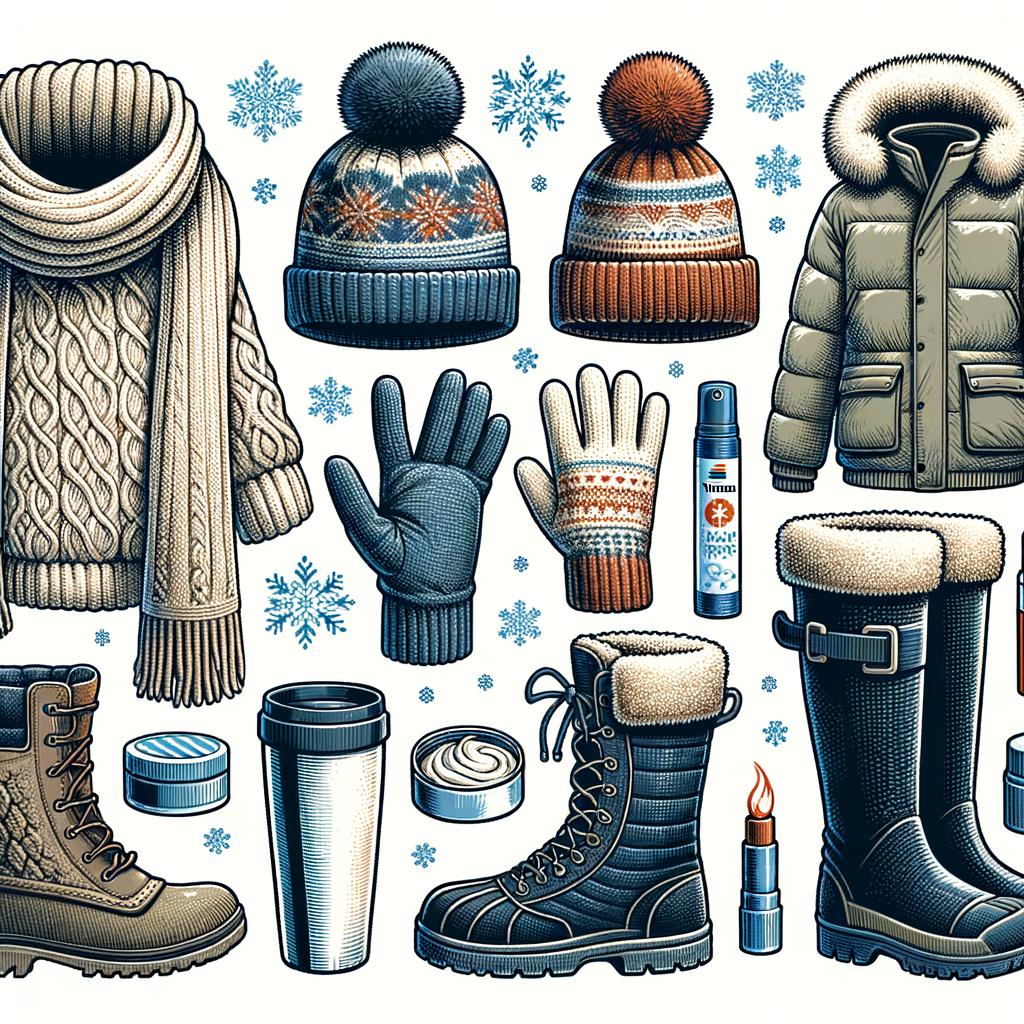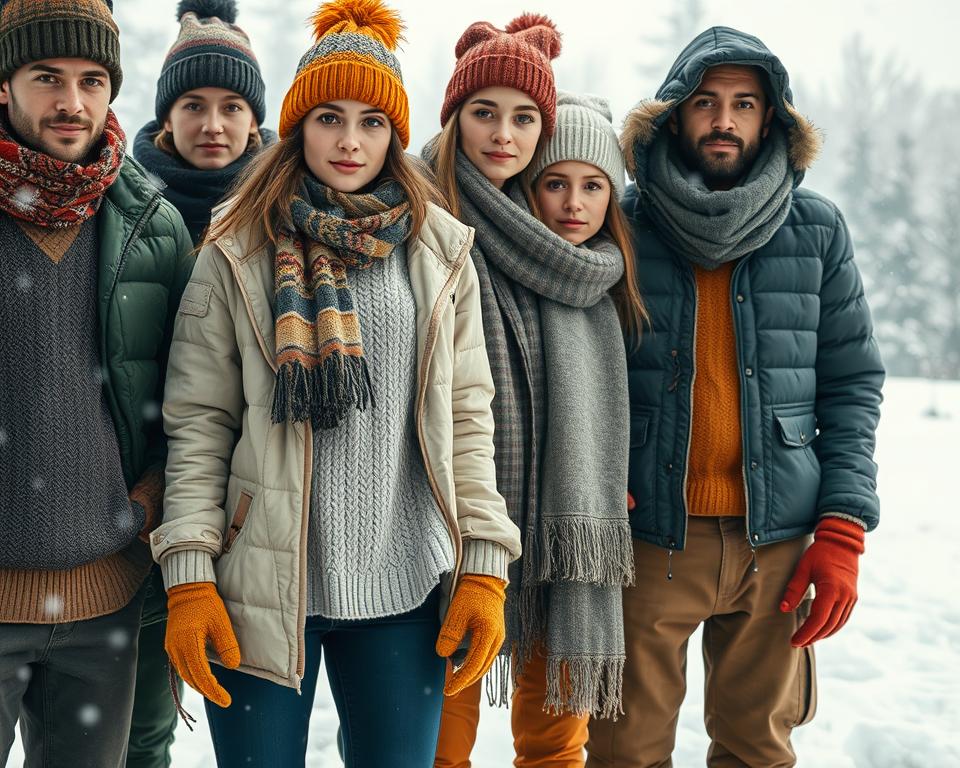Winter Seasonal Wear: 8 Essentials to Keep You Warm

As temperatures begin to plummet, outfitting yourself with the right cold weather clothing becomes paramount. This guide on winter fashion essentials highlights the top 8 items necessary for both function and style during the frigid months. Each piece, from the snug thermal layers to the shielding outerwear, is designed to keep you warm and comfortable.
Whether you’re navigating the urban jungle or enjoying the great outdoors, having the appropriate winter gear is a must. These essentials will not only maintain your body heat but also ensure you remain stylishly dressed, no matter how low the temperatures drop. Invest in the right thermal attire to make the most of your winter activities while staying protected from the cold.
Key Takeaways
- The right outfitting is crucial as temperatures drop.
- Invest in high-quality cold weather clothing.
- Choose items that offer both warmth and style.
- Layering is key for optimal warmth.
- Essential winter gear includes insulated jackets, boots, and accessories.
Insulated Jackets
Insulated jackets are a cornerstone of winter seasonal wear, providing essential warmth in cold climates. Whether you’re hitting the slopes or taking a winter hike, choosing the right type of insulation is crucial for maintaining comfort and warmth.
Understanding Insulation Types
When selecting insulated outerwear, it’s essential to understand the different types of insulation available. Down jackets are lauded for their excellent warmth-to-weight ratio and compressibility. They trap heat effectively, making them a suitable choice for extremely cold conditions. However, down jackets tend to lose their insulating properties when wet.
On the other hand, synthetic fill coats offer consistent warmth even in damp conditions. These jackets are also more affordable and easier to care for than down alternatives. Deciding between down and synthetic fill coats often comes down to your intended activities and the typical weather you’ll encounter.
Choosing the Right Fit
Choosing the right fit for your insulated outerwear is not just about comfort; it’s also critical for optimal performance. A well-fitted jacket should allow for layering while effectively trapping heat and blocking wind. Look for features like adjustable hems and elastic cuffs to ensure a snug fit.
Consider your winter activities when selecting a fit. A more form-fitting jacket might be ideal for skiing or snowboarding, where mobility is crucial. In contrast, a slightly looser fit can be better for general wear, providing extra room for additional layers on particularly cold days. Ultimately, the right fit will streamline your winter look and maximize your warmth.
Layering Basics
Mastering the art of layering for winter is key to enduring the coldest months. This systematic approach involves wearing multiple layers to provide insulation, moisture management, and protection from the elements. Each layer plays a unique role, ensuring you stay warm and comfortable whether you’re indoors or braving the outdoors.
Base Layers
The first step in layering for winter is choosing the right base layers. These are typically made from moisture-wicking materials to keep you dry and comfortable. Opt for thermal wear like merino wool or synthetic fabrics designed to move sweat away from your skin. By staying dry, you’ll avoid the dreaded chill that comes from damp clothing.
Mid Layers
Next, add mid layers for insulation. Fleece pullovers and wool sweaters are popular choices because they trap air and create pockets of warmth. These layers are crucial for retaining body heat, especially on colder days. Look for mid layers that offer a balance between warmth and breathability, giving you the flexibility to add or remove layers as needed.
Outer Layers
The outer layer serves as your first line of defense against wind, rain, and snow. Waterproof shells are essential for this purpose, providing a barrier that keeps moisture out while allowing perspiration to escape. Brands like Patagonia and The North Face offer a variety of high-quality waterproof shells that are both durable and breathable.

When combined, these layers create a comprehensive system that can be adapted for varying conditions. By investing in each of these key components, you’ll be well-prepared to face whatever winter throws your way. Fine-tuning your layering technique ensures that you not only stay warm, but also maintain comfort and mobility.
Winter Boots
When the snow starts falling and the temperature drops, a quality pair of insulated boots becomes essential. Winter boots not only provide warmth but are crucial for ensuring traction on ice and preventing slips and falls. One of the key features to look for is waterproof footwear, which keeps your feet dry in wet and snowy conditions.
Whether you are considering stylish ankle boots or more robust, tall snow boots, make sure they offer a snug fit and reliable insulation. Brands like Columbia and The North Face provide excellent choices that balance both style and function.
Another important aspect of winter boots is the sole. A good pair of winter boots should have a sole designed specifically for traction on ice. This feature is critical for safe winter walks, hikes, or even your daily commute.
For those who need more detailed information, check out this guide on wearing and dressing appropriately for winter. This guide can give you further insights on various winter wear essentials to complement your winter boots.
To sum it up, prioritize finding boots with solid insulation, water resistance, and a grippy sole. Investing in the right pair of boots will not only keep your feet warm and dry but will significantly enhance your safety while navigating through icy terrains.
How Do Women’s Outerwear Essentials Complement Winter Seasonal Wear for Staying Warm?
Women’s outerwear essentials are designed to provide both style and warmth during the winter months. Cozy coats, fashionable jackets, and thermal layers serve as crucial cold weather essentials, ensuring that women stay chic and comfortable while braving the chill, making it easy to embrace the beauty of the season.
Warm Accessories
When winter arrives, staying warm isn’t just about bulky outerwear; the right accessories make a significant difference in combating the cold. These finishing touches are not only fashionable but also functional, protecting your extremities from harsh conditions. By investing in the right warm accessories, you can ensure both comfort and style throughout the winter months.
Beanies and Hats
A cozy beanie or hat is a must-have in your winter arsenal. With a wide variety of options available, from knitted beanies to thermal-lined winter hats, you can effortlessly combine style and function. Remember, most body heat is lost through the head, making a quality hat essential. For more stylish winter headwear ideas, check out this ultimate guide on winter accessories.
Gloves and Mittens
Nothing quite compares to the chill of cold hands. Keep your fingers toasty with well-insulated, possibly waterproof, thermal gloves or mittens. Glove choices range from sleek leather to versatile fleece options, ensuring both dexterity and warmth. The right pair of gloves can make all the difference during outdoor activities or even just a frosty commute.
Scarves and Neck Warmers
Scarves and neck warmers are essential for shielding your neck and face from biting winds. Whether you opt for classic knitted scarves or modern fleece neck gaiters, these accessories add an extra layer of protection where you need it most. For a comprehensive overview of winter wardrobe essentials, you might find this article on winter fashion tips particularly useful. A well-chosen scarf can serve as both functional gear and a stylish statement.
From head to hands, and neck to feet, warm accessories are vital to your winter wardrobe, ensuring you stay stylish and snug in the most frigid temperatures.
FAQ
Q: What are the essential items for winter wear?
A: The essential items for winter wear include thermal layers, insulated jackets, thick sweaters, waterproof boots, and warm accessories like beanies, gloves, and scarves. These pieces ensure you stay warm, dry, and stylish during the cold months. Using keywords such as “cold weather clothing” and “winter gear” can help you find these items more easily.
Q: How do you choose the right insulated jacket for winter?
A: Choosing the right insulated jacket involves understanding insulation types, such as down or synthetic fills, and considering factors like warmth-to-weight ratio, water resistance, and fit. Keywords like “winter jackets” and “insulated outerwear” can guide you to the best options available.
Q: What is the best way to layer clothing for winter?
A: The best way to layer clothing for winter is to start with moisture-wicking base layers, add insulating mid layers like fleece or wool, and finish with a durable, waterproof outer layer. This method traps heat while keeping you dry and protected from the elements. Look up terms like “thermal wear” and “layering for winter” for more tips.
Q: What should you look for when buying winter boots?
A: When buying winter boots, look for features like insulation, water resistance, and good traction to prevent slips on icy surfaces. Fit is also crucial to ensure comfort and support. Searching for “insulated boots” and “snow boots” can help you find the best options.
Q: Which accessories are essential for keeping warm during winter?
A: Essential winter accessories include beanies and hats with thermal lining, insulated gloves or mittens, and scarves or neck warmers. These items keep your extremities warm and are crucial for complete winter protection. Keywords like “winter hats,” “thermal gloves,” and “knitted scarves” can help you find the best accessories.
Q: Why is understanding insulation types important when selecting a winter jacket?
A: Understanding insulation types is important because it affects the jacket’s warmth-to-weight ratio, water resistance, and compressibility. Down insulation is lightweight and very warm, while synthetic fills perform better in wet conditions. Searching terms like “down jackets” and “synthetic fill coats” can provide more insights.
Q: How do base layers help in cold weather?
A: Base layers help in cold weather by wicking moisture away from your skin and providing a snug fit that traps body heat. They are the first line of defense against the cold and are essential for comfortable layering. Look up “thermal wear” for more information.
